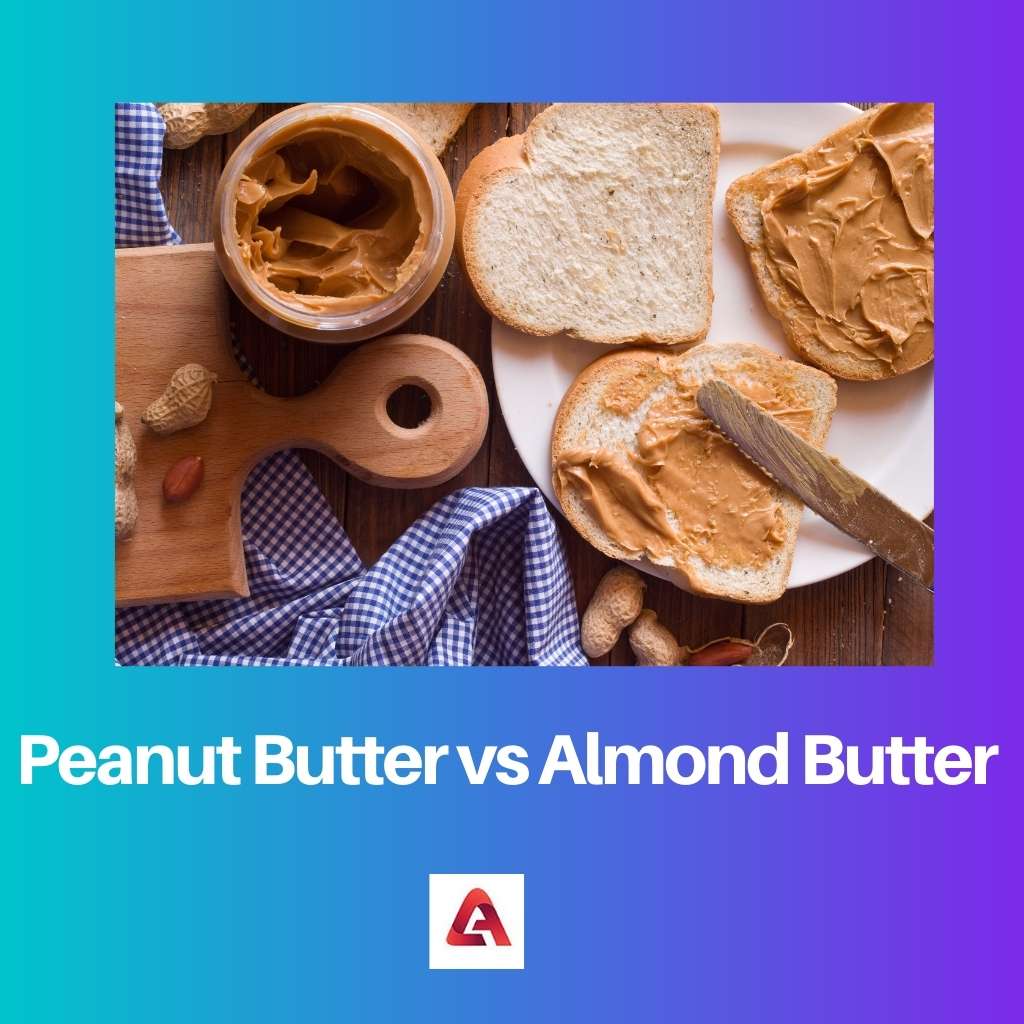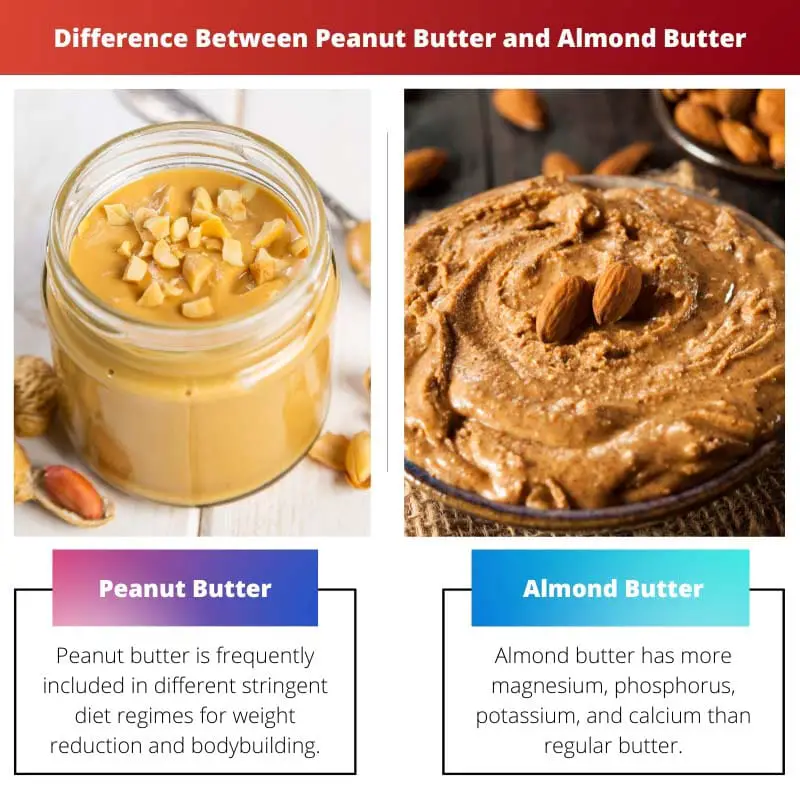When a day begins with a Trey full of delectable breakfast, it becomes a good morning. A healthy breakfast, on the other hand, will provide our nonstop digestive system some much-needed respite.
Bread and eggs are the most typical breakfast combination. While there aren’t many ways to adjust the flavor of eggs, bread gives us various options for making it a pleasurable eating experience.
Some of the most widely consumed popular spreads that would make a list are a butter, jam, and mayonnaise, among others. Various fruit jams and nut butter give us flavor possibilities that are tailored to each individual.
Among the most favored are peanut butter and almond butter. Nuts are healthy in and of themselves, but having a thorough understanding of which ones are superior for specific body conditions would be even more beneficial.
Key Takeaways
- Peanut butter is made from ground peanuts, while almond butter is made from ground almonds.
- Almond butter has a higher nutritional value, with more vitamins, minerals, and healthy fats than peanut butter.
- Peanut butter is more widely available and affordable than almond butter.
Peanut Butter vs Almond Butter
Peanut butter and almond butter are both spreads made from ground nuts that are used as a topping or ingredient in various foods. Almond butter is made in a similar way to peanut butter, by grinding roasted almonds into a paste. It has a slightly sweeter and nuttier flavour than peanut butter.

Peanut butter is healthy in a variety of ways. It does, however, contain fewer fibers than almond butter.
Peanut butter, when consumed in little amounts, may satisfy both the needs of eating tasty meals and being active. It lowers the chance of developing heart and breast problems and also aids in the maintenance of blood sugar levels.
Peanut butter is frequently included in different stringent diet regimes for weight reduction and bodybuilding. Even in unsweetened varieties, almond butter has about half as much sugar as peanut butter.
However, the concentration of sugar level in peanut butter too is considerably low if compared to other various spreads.
Almond butter has more magnesium, phosphorus, potassium, and calcium than regular butter. Without magnesium, the body would be unable to generate energy.
It’s also necessary for maintaining bone health. Potassium is a necessary electrolyte for regular physiological function.
Vitamin E is abundant in both almond butter and peanut butter. Vitamin E lowers the risk of heart disease by reducing inflammation.
It has approximately three times the amount of vitamin E, double the amount of iron, and seven times the amount of calcium as peanut butter.
Comparison Table
| Parameters of Comparison | Peanut Butter | Almond Butter |
|---|---|---|
| Fibre | Peanut butter has less fiber. | Almond butter contains twice as much fibre as peanut butter. |
| Fats | Peanut butter contains more saturated fats. | Almond butter has a lower proportion of saturated fats. |
| Sugar contentment | Peanut butter is high in sugar content. | Almond butter has 50% less sugar than peanut butter. |
| Mineral and Vitamin E | Peanut butter contains less magnesium, phosphorus, and calcium in comparison to almond butter. | Almond butter contains higher ratio of minerals such as calcium, potassium, and magnesium (records for more than 95% of the total mineral body intake.) than other foods. |
| Unsaturated fats | Peanut butter has a lower proportion of unsaturated fats. | Almond butter consists of unsaturated fats in a much larger scale. |
What is Peanut Butter?
Peanut butter is one of the most commonly used spreads or dressing ingredients. It has several health advantages.
Nut butter is a good source of vegetable protein, with each serving containing roughly 7.1 grams. In comparison, one big egg contains slightly over 6 grams of protein, whereas a serving of almond butter contains 6.7 grams.
Peanuts are the main ingredient in peanut butter. Because peanuts are grown underground, they are more likely to come into touch with the very toxic aspergillus mould.
However, because peanut butter must be manufactured, the danger of becoming infected with aspergillus mould is much reduced.

| # | Preview | Product | |
|---|---|---|---|
| 1 |

| Jif Creamy Peanut Butter, 16 Ounces (Pack of 3) | Check Price on Amazon |
| 2 |

| SKIPPY Creamy Peanut Butter, 5 Pound | Check Price on Amazon |
What is Almond Butter?
Almond butter, like peanut butter, is a type of nut butter that is commonly used as a spread or as a basic component in recipes. When it comes to vitamin and mineral content, almond butter outperforms peanut butter in several areas.
The comparison of vitamins and minerals in both nut butter is one such consideration.
It has approximately three times the amount of vitamin E, double the amount of iron, and seven times the amount of calcium as peanut butter. Vitamin E works as an antioxidant to prevent plaque from forming in your arteries, which can restrict them and lead to a heart attack.
Calcium is important for bone health, and iron is necessary for red blood cell production.
Main Differences Between Peanut Butter and Almond Butter
- Peanut butter is lower in fibre, whereas almond butter has a higher fibre content. Fibre is beneficial to our bodies’ metabolisms for a variety of reasons.
- It aids in the improvement of overall health, the feeling of fullness, the provision of prebiotics for the large intestine, and the management of diabetes.
- Peanut butter has a higher proportion of saturated fat in comparison to almond butter.
- Although both nut butter has low sugar content, peanut butter has 50% more sugar content in comparison to almond butter.
- Peanut butter is composed of a lesser number of vitamins and minerals, such as magnesium, phosphorus, and calcium. On the other hand, almond butter contains more of the above-mentioned.
- Peanut butter has a lower proportion of unsaturated fat in comparison to almond butter.






